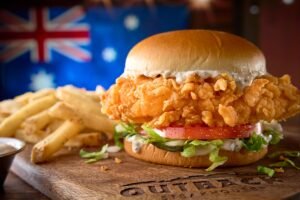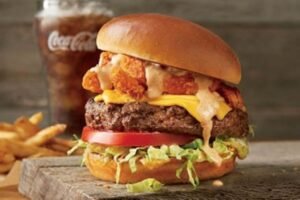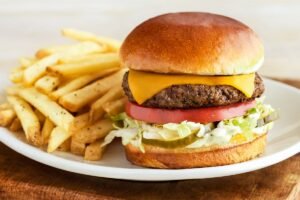Outback’s burger and sandwich lineup exists in a fascinating space – it’s a steakhouse that grinds its own beef daily for burgers, creating handheld options that somehow feel both casual and premium. These aren’t afterthought menu additions but carefully crafted items that give lunch crowds and casual diners a reason to choose Outback over dedicated burger joints.
The burger program launched seriously in 2007 when Outback realized they were losing lunch business to fast-casual chains. Rather than phone it in with frozen patties, they committed to the same quality standards as their steaks – fresh, never frozen beef, hand-formed patties, and preparations that would make burger purists take notice.
The Daily Grind – Fresh Beef Program
Every morning at 6 AM, prep cooks begin grinding beef for the day’s burgers. The blend consists of 50% chuck, 30% brisket, and 20% short rib, creating an 80/20 lean-to-fat ratio that delivers maximum flavor without excessive grease. Each location grinds approximately 80-100 pounds daily, adjusting based on projected sales.
The grinding happens in two passes – first through a coarse die, then through a medium die. This double-grind creates consistent texture while maintaining distinct meat fibers that give burgers their bite. Temperature control stays critical throughout – meat must remain below 38°F to prevent bacterial growth and maintain texture.
Hand-forming happens throughout the day rather than all at once. Cooks press 8-ounce portions into patties using a specific technique – loose packing around edges, slightly tighter in center. This creates even cooking and prevents the hockey puck syndrome plaguing many restaurant burgers. Each patty gets a thumbprint depression in the center, preventing bulging during cooking.
Bun Engineering and Burger Architecture
Outback’s brioche buns arrive par-baked, finishing in-house for maximum freshness. The final baking happens in convection ovens at 350°F for 4 minutes, creating a golden crust while maintaining pillowy interior. Butter-toasting on the flat-top adds another layer of flavor and creates a moisture barrier preventing soggy bottoms.
The layering sequence follows specific protocols designed through extensive testing. Bottom bun gets sauce first, creating a seal. Lettuce goes under the patty, protecting the bun from meat juices. Tomatoes sit atop the patty where heat slightly softens them. Cheese placement depends on melt requirements – American goes directly on hot patty, while aged cheddar might go under to prevent over-melting.
Structural integrity testing involved dropping assembled burgers from 6 inches – if they fall apart, back to the drawing board. The Bloomin’ Burger required seven different configurations before achieving stability. The solution involved strategic sauce placement and specific onion petal positioning that creates interlocking structure.
Temperature Science and Cooking Precision
Burger cooking at Outback follows exact temperature protocols. The flat-top maintains 375°F, hot enough for proper Maillard reaction but not so hot that exteriors burn before interiors cook. Each patty gets pressed once immediately after hitting the griddle – never again, preventing juice loss.
The flip happens at exactly 3 minutes 30 seconds for medium, with adjustments for requested temperatures. Visual cues matter more than timers – proper crust formation, juice pooling on top, and edge color indicate flip readiness. Second side cooking varies based on temperature preference: 2 minutes for medium-rare, 3 for medium, 4 for well-done.
Cheese application timing affects melt quality. American cheese goes on 30 seconds before removal, creating perfect melt without liquidation. Aged cheeses need 45 seconds due to different melting points. Swiss requires steam-dome covering for proper melt without overcooking the patty.
The Sandwich Innovation Lab
The Alice Springs Chicken Sandwich emerged from customer requests to make the popular entrée portable. The challenge involved maintaining sauce distribution and topping adherence in handheld form. The solution came through layering techniques – honey mustard on both bun halves, cheese melted directly onto chicken to act as adhesive for bacon and mushrooms.
The Prime Rib Sandwich faced different challenges. Prime rib’s tenderness makes it fall apart easily, creating eating difficulties. The fix involved specific slicing thickness (exactly 1/8 inch) and grain direction (always against) that maintains structure while ensuring easy biting. The au jus serving temperature matters too – too hot and it dissolves the bread, too cool and fat congeals.
Pulled pork preparation adapted from rib techniques already in use. Pork shoulders undergo the same smoking process as ribs but continue cooking until reaching 203°F internal temperature, where collagen fully converts to gelatin. Hand-pulling rather than machine-shredding maintains texture variation that makes each bite interesting.
Customization Culture
Outback’s burger customization goes beyond standard add-ons. The kitchen accommodates protein swaps – turkey patties, veggie burgers, even grinding fresh chicken for those avoiding red meat. Bun alternatives include lettuce wraps, gluten-free buns, and even Texas toast for those wanting extra indulgence.
Sauce experimentation encouraged by servers leads to discoveries. Bloom sauce mixed with BBQ creates tangy-sweet combination. Ranch mixed with hot sauce mimics buffalo flavor. The kitchen maintains squeeze bottles of various sauces, enabling custom combinations without slowing service.
The “protein style” preparation, borrowed from In-N-Out, wraps burgers in lettuce leaves instead of buns. Unlike the California chain, Outback uses butter lettuce that provides superior structural integrity. This option sees 15% higher orders since keto diet mainstream adoption.
Lunch Hour Dynamics
Burgers and sandwiches drive 65% of lunch business, with average ticket times under 12 minutes from order to delivery. This speed requires strategic preparation – pre-forming patties during slow periods, maintaining optimal flat-top temperature, and coordinating with expeditors for rapid assembly.
The lunch menu offers smaller portions at reduced prices – 6-ounce burgers instead of 8-ounce, single patties rather than doubles. These “Lunch Break Combos” include fries and drink, competing directly with fast-casual pricing while delivering full-service quality.
Peak lunch rush (11:45 AM – 1:15 PM) sees dedicated burger stations operating. One cook handles only patties, another manages buns and assembly, a third coordinates toppings. This specialization reduces errors and speeds service during crunch time.
The Bloomin’ Burger Deep Dive
Creating the Bloomin’ Burger presented unique engineering challenges. The Bloomin’ Onion petals, designed for dipping, don’t naturally work as burger toppings. The test kitchen tried 23 variations before succeeding. The breakthrough came from partially deconstructing cooked Bloomin’ Onions, selecting specific petal sizes that balance coverage without overwhelming.
The bloom sauce required adjustments for burger application. The original dipping sauce was too thin, running off the burger. The burger version reduces cream content and adds mayo for stability. The spice blend intensifies to compensate for reduced quantity – you get less sauce on a burger than with dipping.
Assembly order proves critical. Bloom sauce goes on bottom bun only – top application makes petals slide. Cheese must partially melt before petal application, creating adhesive. Petals overlap in specific pattern ensuring every bite includes crispy onion. The entire assembly process takes 45 seconds longer than standard burgers, justified by premium pricing.
Sandwich Bread Programs
Beyond standard buns, Outback’s sandwich program utilizes various bread options. Sourdough arrives from San Francisco bakeries, maintaining authenticity. The Prime Rib Sandwich’s hoagie rolls come from Italian bakeries using high-gluten flour for structural integrity. Texas toast gets cut fresh from whole loaves, allowing thickness customization.
Toasting protocols vary by bread type. Sourdough gets butter and griddle treatment. Hoagie rolls see dry-toasting in conveyor ovens. Texas toast requires both sides buttered and griddled to golden-brown. These specific techniques maximize each bread’s characteristics while preventing sogginess.
Gluten-free options improved dramatically recently. Earlier versions used frozen buns that crumbled easily. Current gluten-free buns arrive fresh from dedicated bakeries, maintaining structure comparable to wheat versions. Cross-contamination prevention involves separate toasters and dedicated prep areas.
Vegetarian and Alternative Options
The veggie burger evolved from frozen hockey puck to house-made creation. Current version combines black beans, quinoa, mushrooms, and vegetables, bound with eggs and breadcrumbs. Each patty gets hand-formed daily, grilled on separate section to prevent meat contamination.
Turkey burgers use fresh ground turkey breast mixed with seasonings and moisture-retaining ingredients (usually mayo or Greek yogurt) preventing dryness. These cook on lower temperature (350°F) for longer time, ensuring food safety without overcooking.
The Impossible Burger appears at select locations, prepared on dedicated equipment to maintain vegetarian status. Seasoning and cooking techniques mirror beef burgers, creating familiar flavors for plant-based eaters. Early adoption shows 20% attachment rate, exceeding expectations.
Fries and Sides Strategy
Burgers and sandwiches automatically come with Aussie Fries, but substitutions reveal interesting patterns. Sweet potato fries substitution occurs in 30% of orders. Onion rings in 15%. Side salads in 12%. These preferences inform kitchen prep quantities and staffing decisions.
The Aussie Fries themselves deserve recognition. Fresh-cut daily from whole potatoes, they undergo a two-step cooking process. Initial blanching at 325°F for 3 minutes precooks interiors. Final frying at 375°F for 2 minutes creates crispy exteriors. The seasoning blend includes salt, paprika, and other spices applied immediately after frying.
Loaded fries options transform basic sides into meal components. Cheese fries add Monterey Jack and cheddar. Chili cheese fries incorporate house-made chili. “Bloomin’ Fries” top with bloom sauce and crispy onion pieces. These additions turn burger meals into shareable experiences.
The Bottom Line
Outback’s burger and sandwich program succeeds by applying steakhouse quality standards to handheld formats. Daily ground beef, fresh preparations, and attention to detail elevate these items beyond typical casual dining offerings. While they may never be known primarily for burgers, Outback created a program that satisfies cravings and drives significant lunch business.
The sandwich selection fills gaps in the menu, providing options for those wanting Outback flavors in more casual formats. From the engineering marvel of the Bloomin’ Burger to the indulgent simplicity of the Prime Rib Sandwich, these items prove that handhelds deserve the same respect as plated entrées.
Whether you’re grabbing a quick lunch, feeding picky eaters, or simply craving a great burger, Outback’s handheld options deliver satisfaction that justifies choosing a steakhouse for your burger fix. They’ve proven that with the right approach, a steakhouse can indeed make burgers worth talking about.


